Submitted:
16 July 2024
Posted:
16 July 2024
You are already at the latest version
Abstract
Keywords:
1. Introduction
- Static Slicing which has preconfigured and defined rules or policies. It does not offer flexibility and does not change with carrying user demands or network conditions.
- Threshold-based Scaling which is a reactive approach that scales up and down based on the predefined threshold to scale.
- Priority-based Resource Allocation which is another rule based network slice management whereby network slices are assigned priority levels. This ensures higher priority slices get the required resource before considering allocating resources to any other lower priority network slice.
- Heuristic-based Orchestration is a reactive approach, which uses Heuristic algorithms or rule of thumb to make decisions on network slice resource allocation. This decision could be based on various rule of thumb such as historical data, expert knowledge or simplified model of the slice behaviour
- Policy-based Management which is based on predefined policies to define the rules for allocating, orchestrating and scaling network resources
- Propose an ML-based framework for optimal orchestration a New Vertical 5G Enterprise Network As A Service – Company Network As A Service (cNAAS).
- Propose and validate an Enhanced Sub Slice Machine (eSS) Learning Pipeline Model
- Propose and validate an alternative Network Function Chaining
- Propose and validate an auto Machine Learning Model Comparison Fit In Real Time
- Propose an enabler for seamless collaboration and integration between network providers and users
2. Literature Review
A. 5G Network Slicing
B. Resource Management in Network Slicing
C. Machine Learning for Network Optimisation
3. The Proposed CNaaS Framework
A. System Architecture
- Reinforcement learning which is an offline learning that learn historical data and predict traffic trends and anticipated demands of 5G network slice. This component is responsible for forecasting future network traffic patterns for each network slice.
- AutoML, which is an online learning that continually adapts to the dynamic environment conditions and evolving user requirements. The RL agent adaptively updates its policy based on the live feedback, refine its predictions and enables its ability to dynamically respond to the evolving traffic pattern.
- The Network Slice Requirements Analyser, eSS with an inbuilt metrics KPI estimator and which uses lazypredict, a python module to analyse the dataset, automatically select best fit machine learning algorithm for the given network dataset and then train the best supervised machine learning algorithm (e.g., Random Forests, SVM, Gradient Boosting, Neural Networks). This analyses the network traffic data to identify the 5G network slice requirement for the given network pattern. It identifies the best fit supervised learning classifier (e.g., Decision Trees, Support Vector Machines) for training, feature engineering, hyperparameter tuning and selecting the model with optimal performance considering the key metrics such as latency, throughput, bandwidth, jitter and packet loss rate. Although lazypredict is configured by default due to its lightweight capabilities, AutoML can also be configured where computational storage is not a challenge to take advantage of its online learning and automating features.
- Network Sub-Slice Mapper, part of the eSS which uses bespoke inbuilt python function to select the best-fit or alternative best fir network functions configurations to be chained based on available network resources and predicted network resource requirements for future slices. The most suitable network sub-slice is mapped to the applications for optimal performance considering the key metrics such as latency, throughput, bandwidth, jitter and packet loss rate.
B. LazyPredict for Algorithm Selection
C. Time-Series Forecasting for Traffic Prediction
4. Case study
A. Simulation Setup
- eMBB (Enhanced Mobile Broadband): Caters for high speed, capacity and bandwidth mobile broadband services like immersive augmented reality (AR), video streaming, virtual reality (VR) and web browsing.
- URLLC (Ultra-Reliable Low-Latency Communications): Enables reliable data transmission and Caters to mission-critical applications with stringent latency such as autonomous cars, remote surgery and industrial automation.
- mMTC (Massive Machine-Type Communications): Enabling massive connectivity for IoT devices that requires low data rate and low energy consumptions requirements in smart city and sensor network applications.
B. Benchmarks
C. Implementation Details
5. Performance Evaluation
A. Throughput Analysis
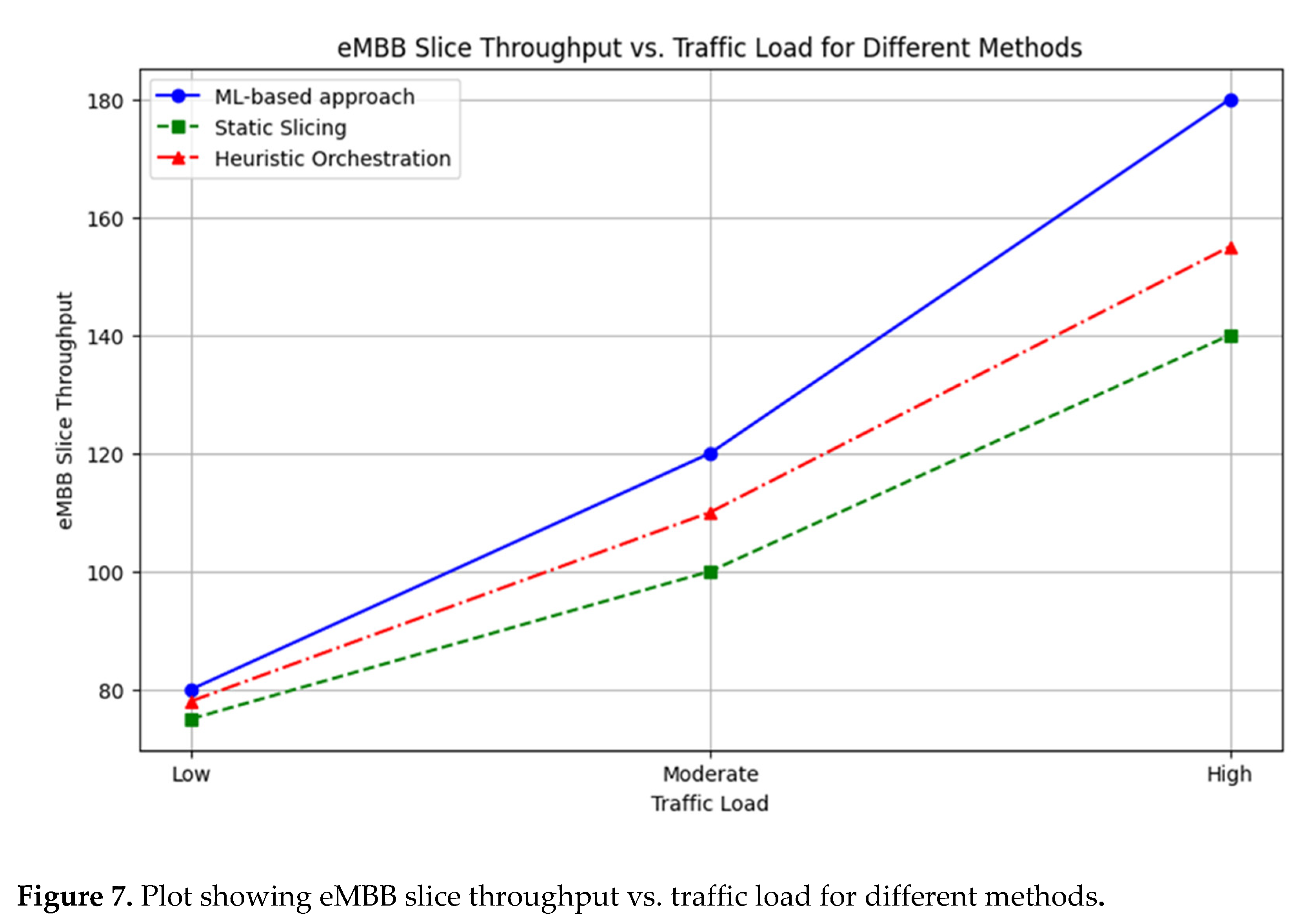
B. Latency Performance
C. Resource Utilisation
Alterative Network Function Chaining
D. Conclusion and Discussion
References
- Jiang, W.; Fricker, C.; Izal, M.; Rahman, M.; Woodward, M. Machine Learning for 5G Network Slicing and Orchestration: Opportunities, Challenges, and Solutions. IEEE Communications Surveys & Tutorials 2022, 24, 772–805. [Google Scholar]
- Shafi, M.; Molisch, A.F.; Smith, P.J.; Haustein, T.; Zhu, P.; De Silva, P.; Tufvesson, F. 5G: A tutorial overview of standards, trials, challenges, deployment, and practice. IEEE Journal on Selected Areas in Communications 2017, 35, 1201–1221. [Google Scholar] [CrossRef]
- Zhang, H.; Liu, N.; Chu, X.; Long, K.; Aghvami, A.H.; Leung, V.C. Network slicing based 5G and future mobile networks: mobility, resource management, and challenges. IEEE Communications Magazine 2019, 57, 138–145. [Google Scholar] [CrossRef]
- Foukas, X.; Patounas, G.; Elmokashfi, A.; Marina, M.K. Network slicing in 5G: Survey and challenges. IEEE Communications Magazine 2017, 55, 94–100. [Google Scholar] [CrossRef]
- Ordonez-Luciano, J.; Ameigeiras, P.; Lopez, D.; Ramos-Munoz, J.J.; Lorca, J.; Folgueira, J. Network slicing for 5G with SDN/NFV: Concepts, architectures, and challenges. IEEE Communications Magazine 2017, 55, 80–87. [Google Scholar] [CrossRef]
- Afolabi, I.; Taleb, T.; Samdanis, K.; Ksentini, A.; Flinck, H. Network slicing and softwarization: A survey on principles, enabling technologies, and solutions. IEEE Communications Surveys & Tutorials 2018, 20, 2429–2453. [Google Scholar]
- Rost, P.; Mannweiler, C.; Sciancalepore, D.; Wosinska, L.; Costa-Requena, J.; Faragó, A.; Kentis, A. Network slicing to enable scalability and flexibility in 5G mobile networks. IEEE Communications Magazine 2017, 55, 72–79. [Google Scholar] [CrossRef]
- Baumgartner, A.; Huynh VP, M.; Mitschele-Thiel, A. On the optimal re-allocation of resources for sliced mobile networks. IEEE Transactions on Network and Service Management 2020, 17, 344–357. [Google Scholar]
- Xu, Y.; Yang, K.; Wang, J.; Zhou, L.; Pan, M. Deep reinforcement learning for network slicing with resource allocation in 5G communication networks. IEEE Transactions on Vehicular Technology 2020, 69, 11295–11305. [Google Scholar]
- Yan, M.; Abbas, G.; Boubendir, A.; Bouallegue, R.; Chang, Z. (2019). A hierarchical orchestration framework for 5G network slicing. In 2019 IEEE Wireless Communications and Networking Conference (WCNC) (pp. 1-7). IEEE.
- Zhao, Y.; Hu, Y.; Yu, J.; Xiao, W.; Li, J.; Salyga, J. Reinforcement learning-based resource allocation for slice admission control and resource optimisation in 5G networks. IEEE Transactions on Network Science and Engineering 2021, 8, 3133–3145. [Google Scholar]
- Rakovic, V.; Pitakandhi, P.; Malanin, M.; Amin, R.; Barac, F.; Araújo, A.; Gupta, A. Reinforcement learning for dynamic resource allocation in sliced radio access networks. IEEE Transactions on Cognitive Communications and Networking 2021, 7, 1095–1108. [Google Scholar]
- Wang, Y.; Qiao, H.; Li, G.; Zhang, J. (2019). Mobile traffic prediction using LSTM neural network. In 2019 International Conference on Computing, Networking and Communications (ICNC) (pp. 485-489). IEEE.
- Liao, C.H.; Liu, C.H.; Ke, C.H. Deep learning-based proactive resource allocation for network slicing in 5G networks. IEEE Transactions on Network Science and Engineering 2022, 9, 47–60. [Google Scholar]
- Zhao, Y.; Chen, Y.; Farha, F.; Li, J.; Salyga, J.; Tung, Y. (2022). Hybrid Machine Learning for Network Optimisation: Opportunities and Challenges. arXiv preprint arXiv:, arXiv:2205.05290.
- Mestres, A.; Munoz, R.; Baranda, J.; Breitbach, M.; Sosa, I.; Durmuth, A.; Navarro, L. Hybrid Machine Learning Enabling Resource Optimisation in Future Networks. IEEE Network 2022, 36, 302–308. [Google Scholar]
- Smail, O.; Hoceini, S.; Benkara, A.; Mellouk, A. Hierarchical resource orchestration framework for network slicing in 5G networks. IEEE Access 2021, 9, 58489–58504. [Google Scholar]
- Hochreiter, S.; Schmidhuber, J. Long short-term memory. Neural Computation 1997, 9, 1735–1780. [Google Scholar] [CrossRef] [PubMed]
- Krizhevsky, A. , Sutskever, I., & Hinton, G. E. (.
- Ma, X.; Tao, X.; Qiao, F.; Zhang, Z.; Yang, J.; Liu, P. Deep Learning for Mobile Internet Traffic Prediction: A Survey. ACM Computing Surveys (CSUR) 2021, 54, 1–38. [Google Scholar]
- Mijumbi, R.; Serrat, J.; Gorricho, J.; Bouten, N.; De Turck, F.; Boutaba, R. Network function virtualisation: State-of-the-art and research challenges. IEEE Communications Surveys & Tutorials 2016, 18, 236–262. [Google Scholar]
- Hawilo, H.; Shami, A.; Mirahmadi, M.; Asal, R. NFV: state of the art, challenges, and implementation in next generation mobile networks (vEPC). IEEE Network 2014, 28, 18–26. [Google Scholar] [CrossRef]
- Khatibi, S.; Correia, L.M. Modeling of virtual radio resource slicing. IEEE Access 2019, 7, 97245–97266. [Google Scholar]
- Ordonez-Lucano, J.; Ameigeiras, P.; Lopez, D.; Ramos-Munoz, J.J.; Lorca, J.; Folgueira, J. Network slicing for 5G with SDN/NFV: Concepts, architectures, and challenges. IEEE Communications Magazine 2017, 55, 80–87. [Google Scholar] [CrossRef]
- Baumgartner, A.; Huynh VP, M.; Mitschele-Thiel, A. On the optimal re-allocation of resources for sliced mobile networks. IEEE Transactions on Network and Service Management 2020, 17, 344–357. [Google Scholar]
- Polese, M.; Giordano, M.; Zema, N.R.; Tinnirello, I.; Lizzit, D.; Zorzi, M. An Open-Source Framework for 5G Network Slicing Simulation. IEEE Access 2022, 10, 19527–19544. [Google Scholar]
- Richart, M.; Balios, J.; Navarro-Ortiz, J.; Sallent, O. Resource Slicing for Network Slicing: Concepts, Protocol Support and Challenges Ahead. IEEE Communications Magazine 2021, 59, 30–37. [Google Scholar]
- Shree, K.S.; De Michieli, L.; Rossi, M.; Kulkarni, S.; Tinnirello, I. An open-source simulator for 5G network slicing on commodity hardware. IEEE Access 2021, 9, 113573–113587. [Google Scholar]
- Muñoz, R.; Baranda, J.; Laselva, D.; Mogensen, P.E.; Cu, C. (2020). Slicer: An NS-3 module for 5G E2E multi-tenant environment. In 2020 IEEE 25th International Workshop on Computer Aided Modeling and Design of Communication Links and Networks (CAMAD) (pp. 1-6). IEEE.
- 5G PPP Architecture Working Group. (2019). View on 5G Architecture (Version 3.0). 5G Infrastructure Public Private Partnership (5G PPP).
- 3GPP TS 28.554, "Management and orchestration; 5G end to end Key Performance Indicators (KPI)," v16.3.0, October 2020.
- Jain, R. (2008). The art of computer systems performance analysis: techniques for experimental design, measurement, simulation, and modeling. John Wiley & Sons.
- Kozat, U.C. Model and system benchmarking in telecommunications: Concepts, metrics, and tools. IEEE Transactions on Cognitive Communications and Networking 2019, 5, 584–598. [Google Scholar]

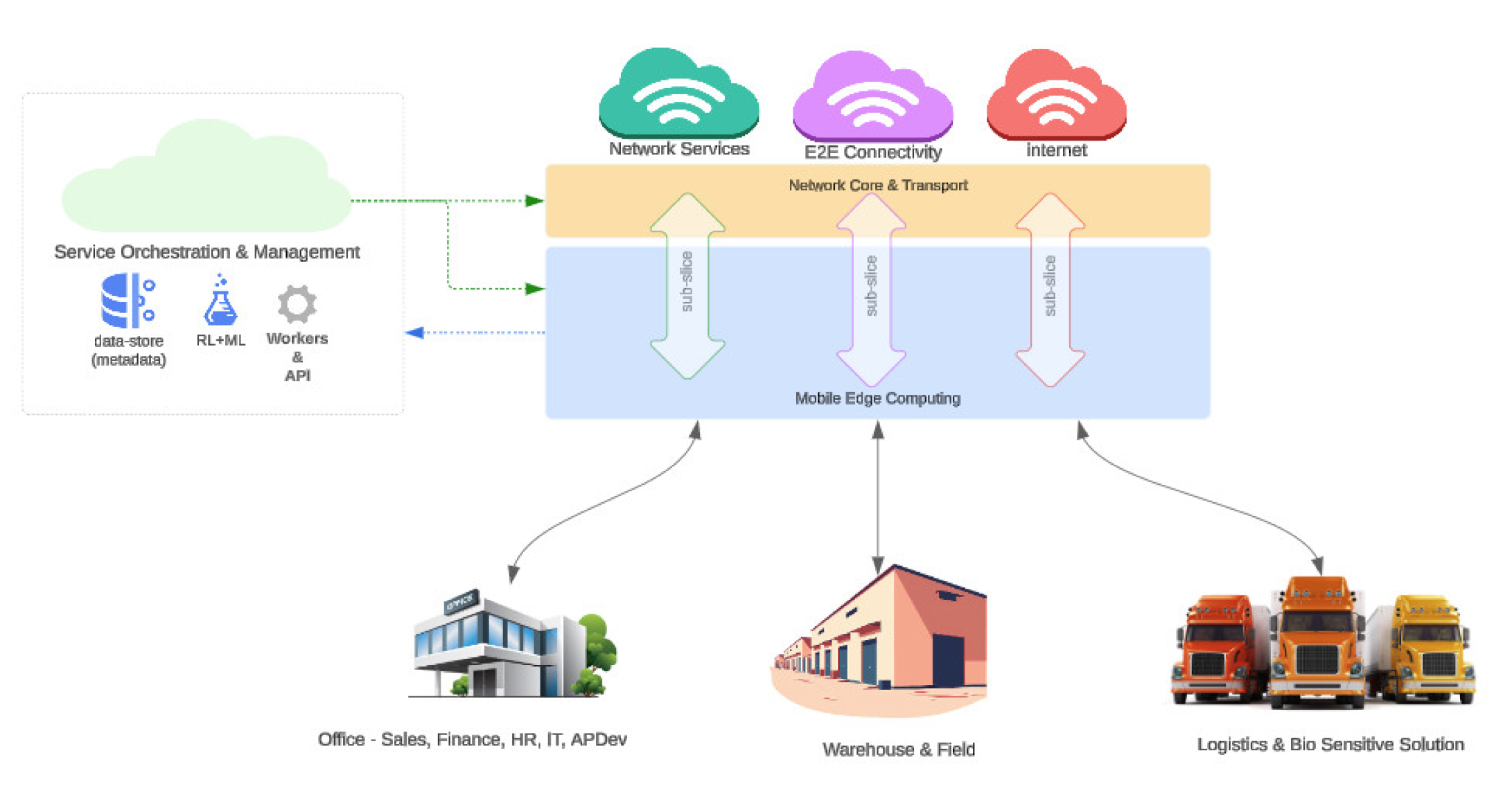

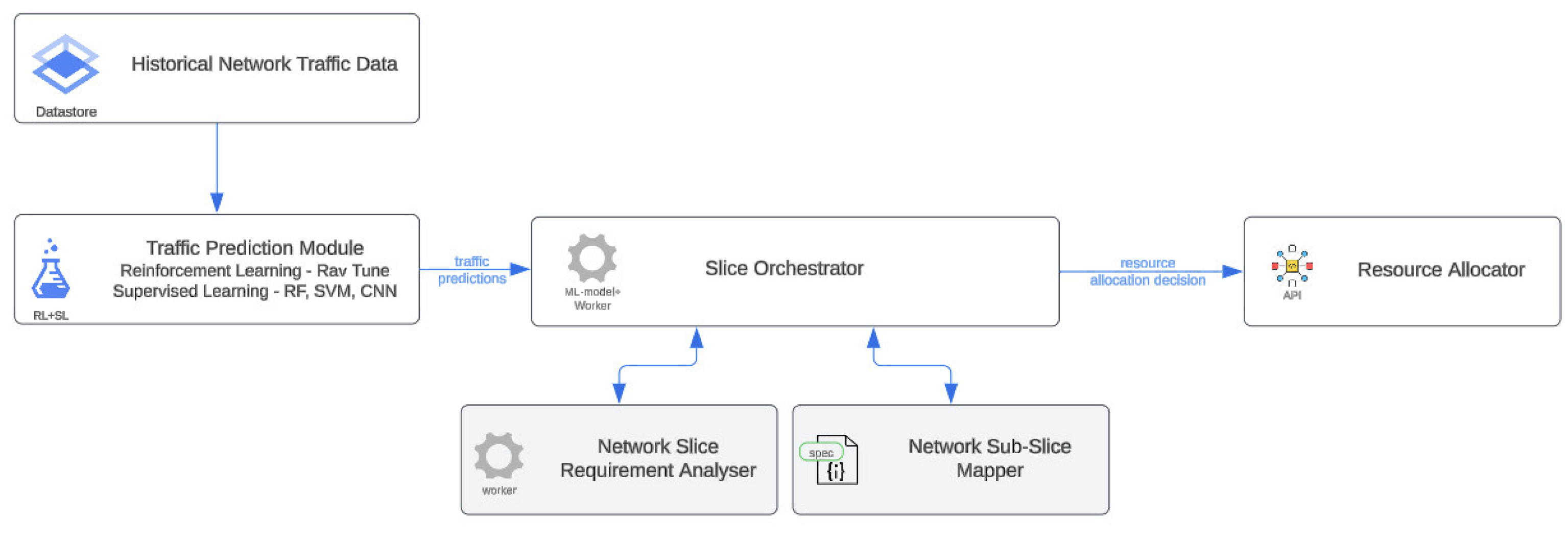
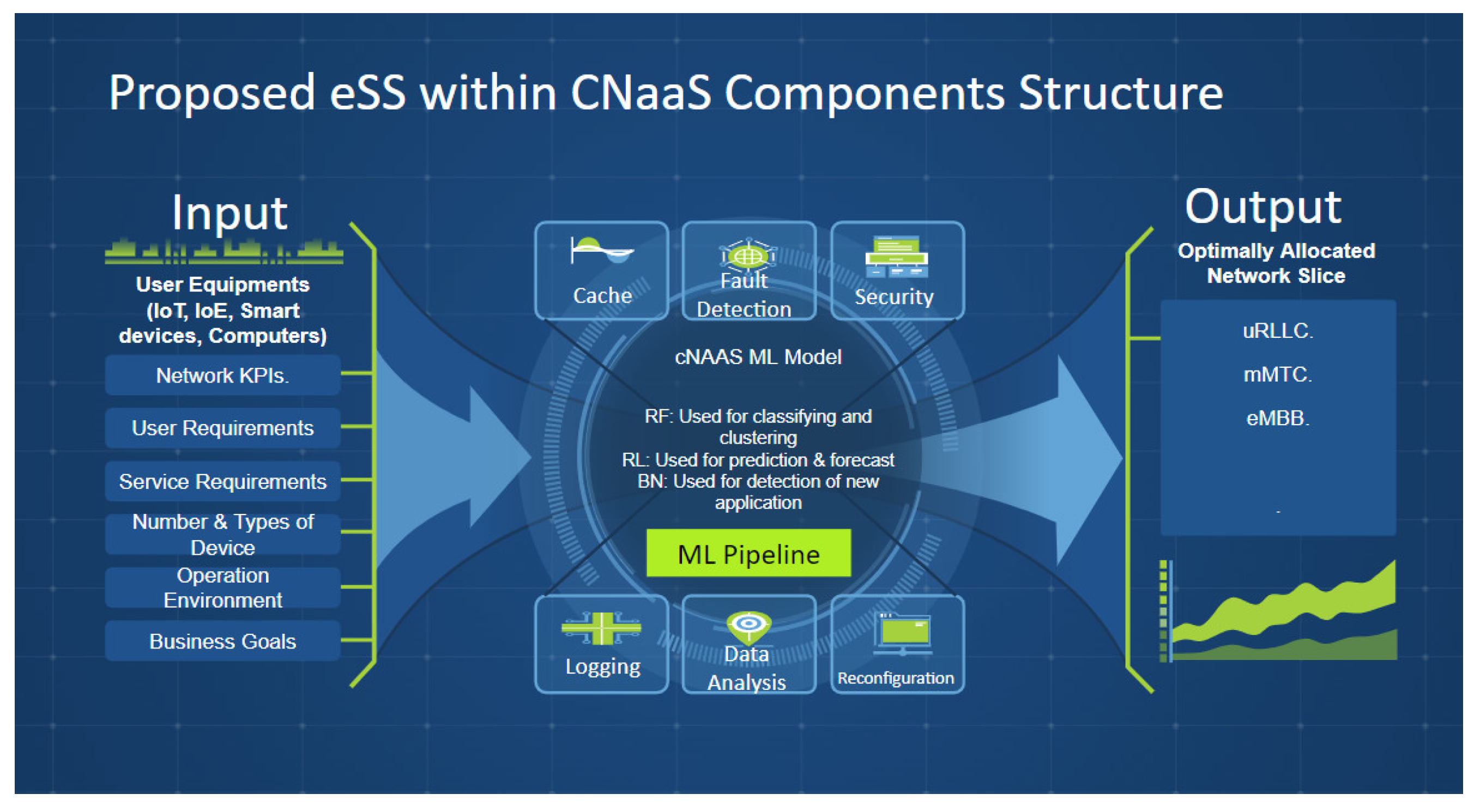
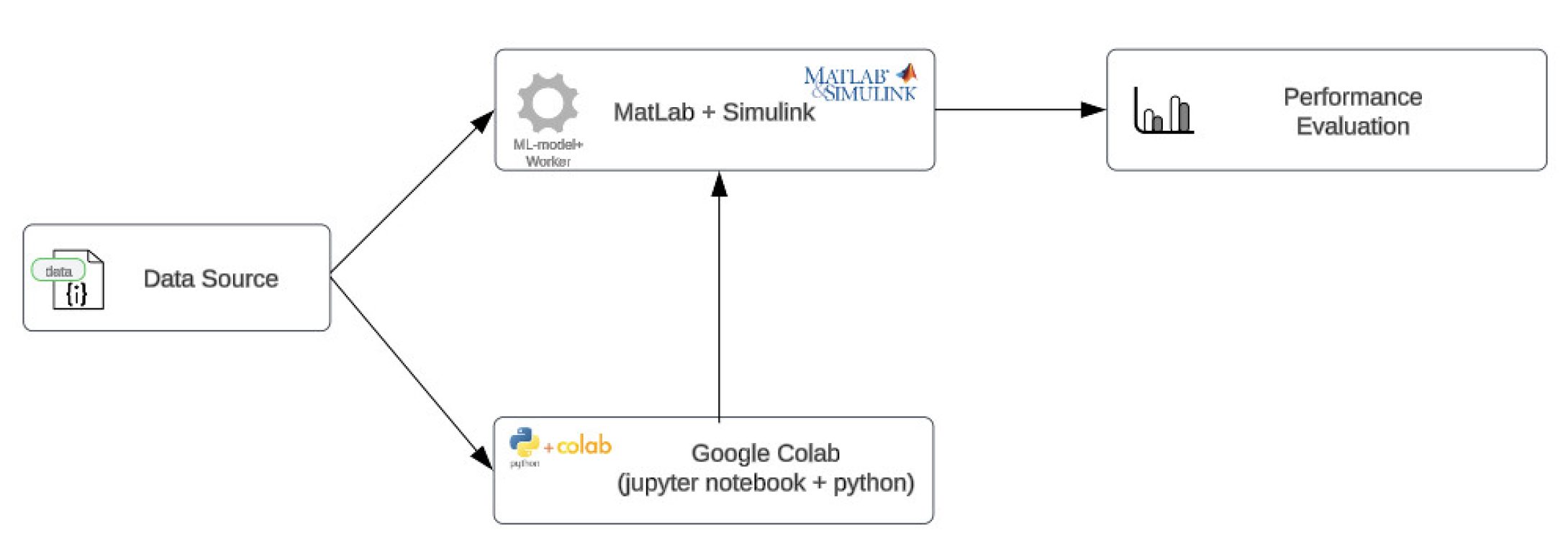
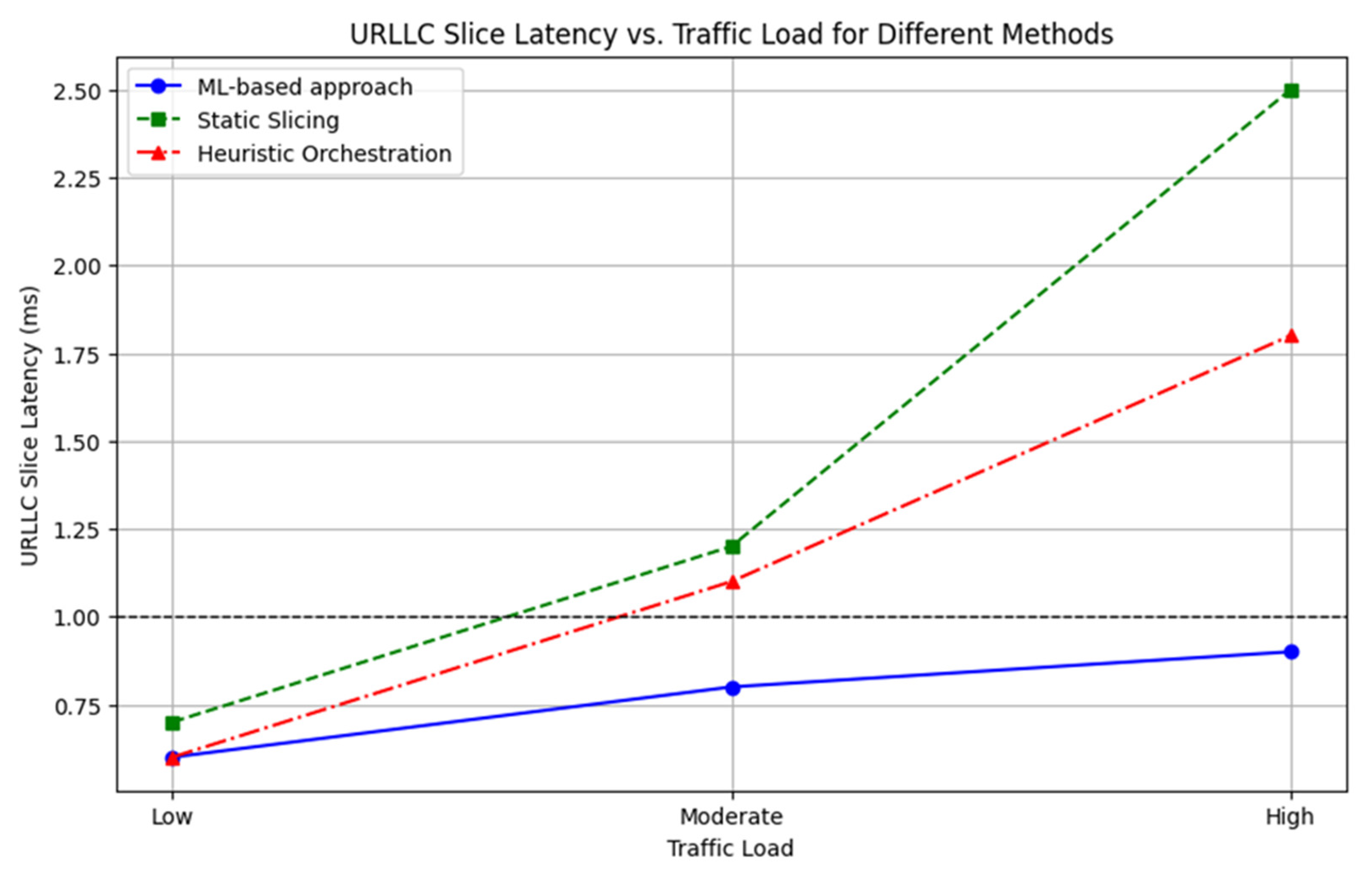
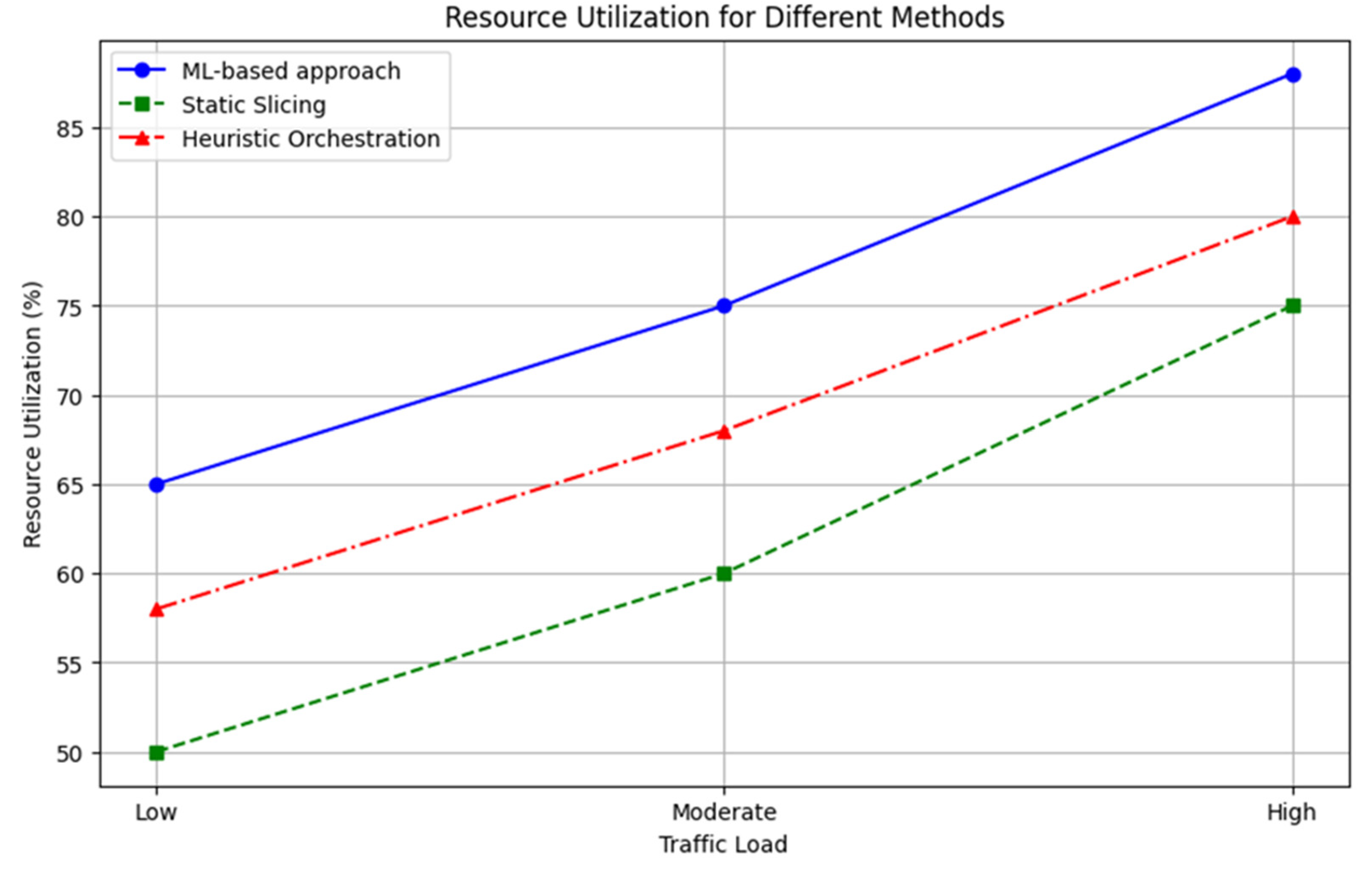
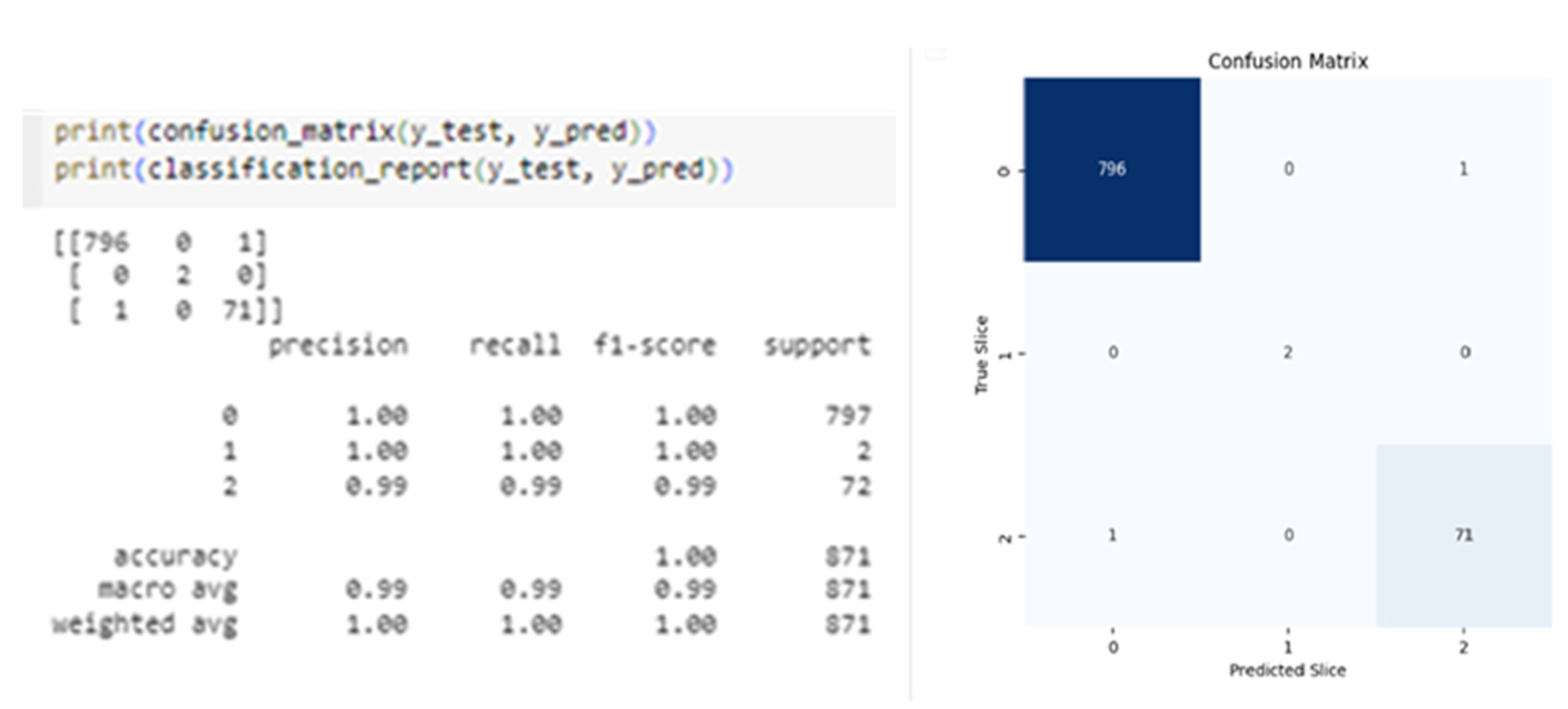

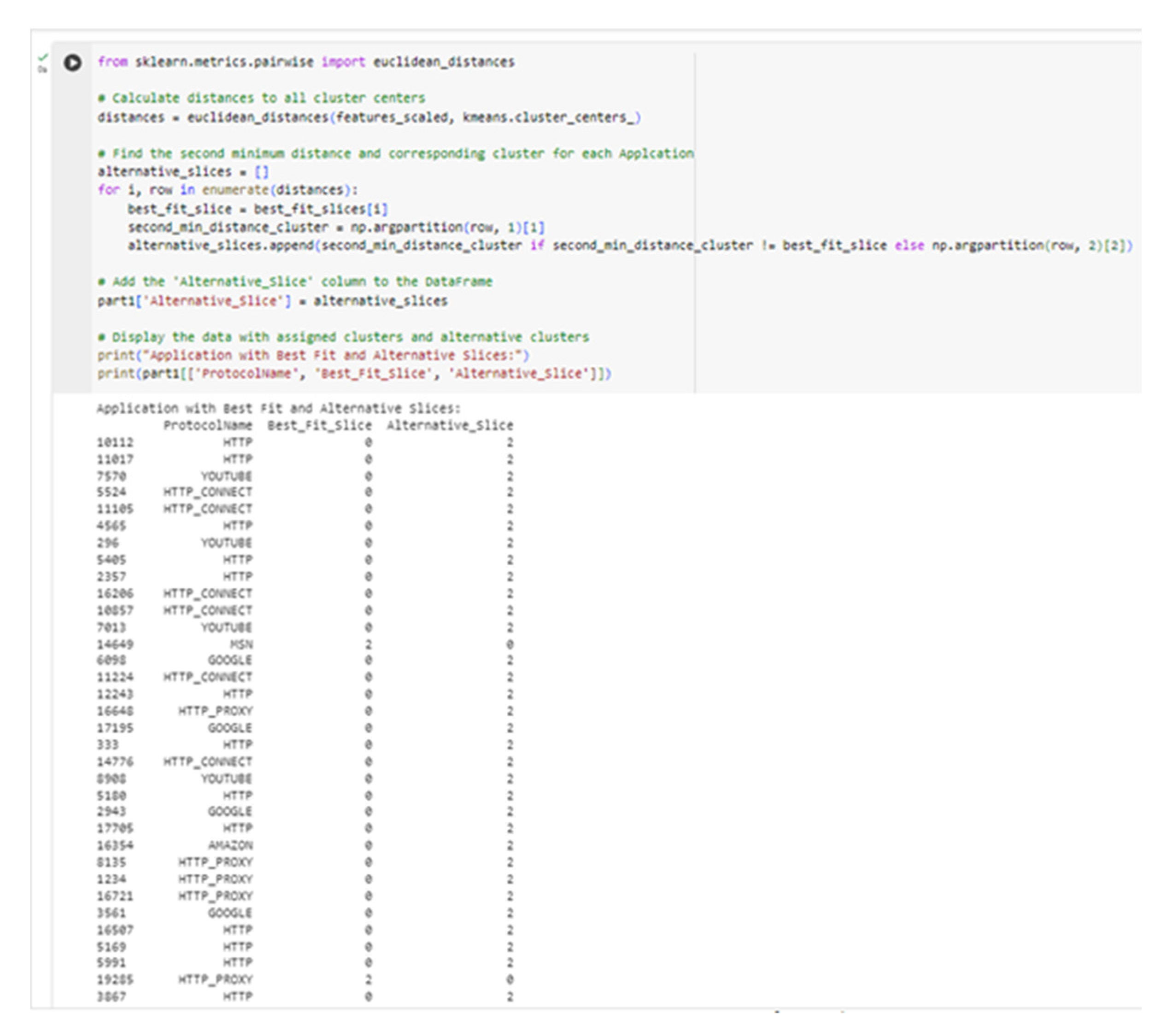
Disclaimer/Publisher’s Note: The statements, opinions and data contained in all publications are solely those of the individual author(s) and contributor(s) and not of MDPI and/or the editor(s). MDPI and/or the editor(s) disclaim responsibility for any injury to people or property resulting from any ideas, methods, instructions or products referred to in the content. |
© 2024 by the authors. Licensee MDPI, Basel, Switzerland. This article is an open access article distributed under the terms and conditions of the Creative Commons Attribution (CC BY) license (http://creativecommons.org/licenses/by/4.0/).




